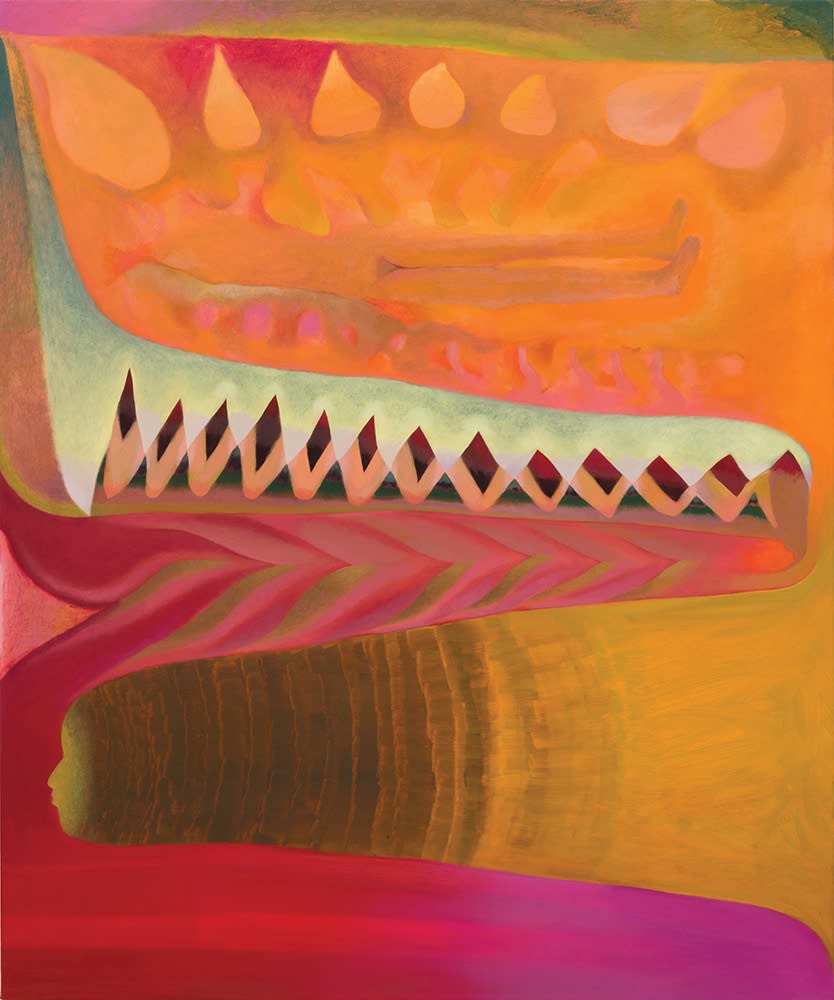Nature, the body, and the psyche seem to be one in Kristy Luck’s paintings, but there is nothing saccharine or overtly mystical about her unifying vision. The Los Angeles–based artist depicts fields of color pulsing with the vitality of pressures countering one another and then yielding, as entities appear to emerge, merge, and change. Her works evoke generative and transformative processes that are equally at play in internal and external realms, accentuating the continuity between self and the larger world.
At the entrance to Luck’s exhibition, “Transformer,” hung an arresting oil-and-wax painting from 2016, Hands, in which a pair of long-fingered aqua-colored hands pushes against or holds up an arched gold plane, perhaps a door. The eleven other works on view (all 2019 or 2020) were less illustrative, more abstractly suggestive. Scale matters, but not predictably. Within small and large paintings alike, Luck oscillates between micro- and macrocosmic perspectives. Forms distilled from botany, geology, and biology—stems, thorns, pods, clefts, abysses, teeth, gums—interact and reverberate in ambiguous space, reading variably as minute and expansive. Each arena is energized by jewel tones, usually spiked with a dose of complementary color. Shapes recur in fugue-like repetitions, and surfaces vary in opacity from foggy to dense.
In Cloud Throat, among the most absorbing works in the show, a quiet quadrant of warm gray at the lower right of the canvas is topped with a neat row of tiny trees standing upon a lyrical swale—a little moment of naturalism found amid a scene otherwise characterized by animist ebullience. A series of concentric flourishes blooms in shades of olive, cobalt, and lime at the lower left, while swaying columnar forms morph into vivid, dappled plumes of violet at top. Suspended centrally in the composition is a planetary orb, whose gravitational pull might be responsible for all the tidal action taking place.
Human body parts appear amid Luck’s fissures, hillocks, blossoms, and other loose references to the natural world. In Overthinker, a headless, supine female nude radiates glowing petals; below, the back of a silhouetted head in profile extends in stuttering daubed stripes. In Soft Touch, the rectangular canvas as a whole doubles as torso. Two exaggerated, mismatched green arms enter the composition from the sides, palms down against the amorphous middle. White amoebic lungs float above a dark, uterine cavity.
Other paintings similarly allude to female reproductive organs, those unseen anatomical parts historically held accountable for women’s moods and behaviors. In Black Sun, a stylized gorge doubles as an internal site of fertilization. Throughout this dazzling exhibition, there was a fluid equivalency between shapes and events inside the body and what happens on the outside as atmosphere, environment, and weather. Luck mimes a rich pyscho-sensuality, nodding to early twentieth-century transcendental modernists like Agnes Pelton and Henrietta Shore along the way. Her proudly feminine imagery feels like an act of reclamation: why not ovaries as suns, as seeds, as themselves?


